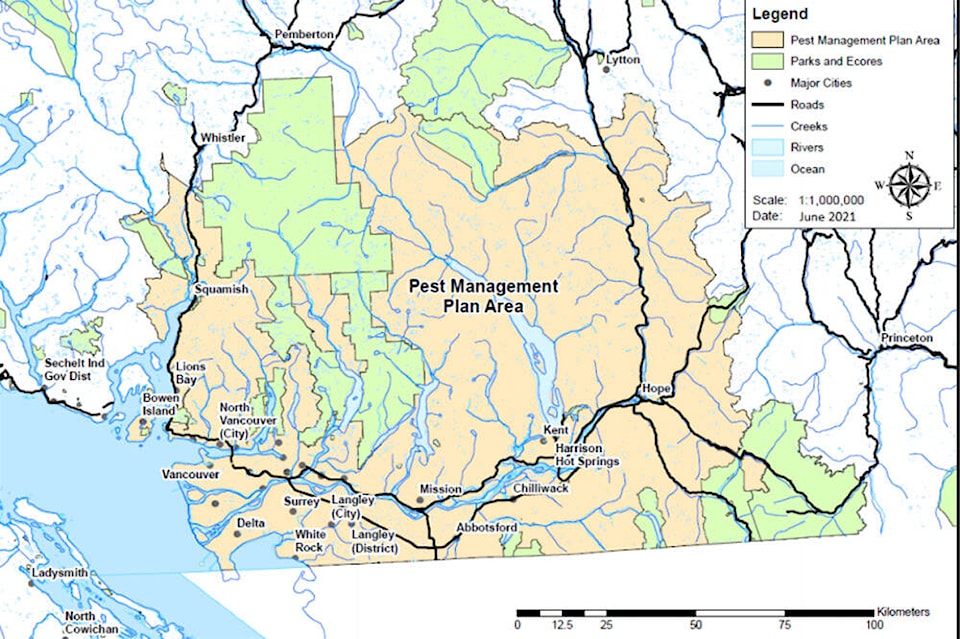An Abbotsford palliative-care doctor has aired her concerns about a known carcinogen being applied to forests in the Fraser Valley and Lower Mainland.
Dr. Chantal Chris has asked BC Timber Sales (BCTS) and the government to extend its public comment period before moving ahead with a five-year pest management plan (PMP) that includes applying glyphosate to forested areas stretching from Hope to Squamish. Those same forests include areas where Indigenous people harvest plants for medicine and ceremony.
“The continued use of chemical herbicides, including glyphosate – which has been linked to cancer and is named in ongoing lawsuits – is a matter of enormous public importance,” Chris wrote in an open letter to BCTS, the government and others on March 26. “We have concerns about the aerial and ground application of these chemicals to vital native plant species, as well as concerns about potential contamination of waterways. Glyphosate, triclopyr, Formula 40 can all have serious consequences on aquatic life.”
The application covers Stó:lō, St’át’imc, Nlaka’pamux, Squamish, and Tsleil Waututh territories, Chris said.
A notice was published in the Feb. 25 edition of the Hope Standard announcing the drafting of plan, by BCTS and the BC Ministry of Forests, Lands, Natural Resource Operations and Rural Development.
A draft of the PMP was available to view at the Chilliwack and Sea to Sky Natural Resource District offices, and is still available online. The public comment period closed on March 27. Chris has asked for an extra 60 days for the public to comment, but has not had a reply to her request.
The plan explains that glyphosate will be applied selectively, by backpack sprayers, stump treatments, individual tree injection, helicopters with boom sprayers, and cone sprayers. Triclopyr will be applied in fewer situations, and will be via basal applications. The Formula 40 will be applied by individual tree injections, in more rare circumstances.
Dr. Chris believes the public should have more time to consider the plan and consult with BCTS.
“Given the complexity and potential severity of these issues, 30 days is simply not enough time for members of our communities to be adequately engaged and provide feedback,” she said. “Berry pickers, medicine harvesters, and others who rely on these lands and forests for food and cultural purposes must have sufficient time to be consulted.”
The proposed duration of the plan has a start date of this Friday, April 1, ending March 31, 2027. The plan also details use of manual cutting, using brush saws and chainsaws.
The draft plan, completed by Peter Cherniwchan of BCTS, does state the importance of Indigenous uses of plants in the region.
“It should be noted that many brush species listed under the individual brush complex codes above are of high traditional use values by First Nations communities,” the plan states. “These species include but are not limited to: Thimbleberry, Salmonberry, Elderberry, Raspberry, Huckleberry, Blueberry, Saskatoon berry, Devil’s club and salal. Traditional use values of forest vegetation species must be considered during brush treatment planning and implementation.”
The plan explains that use of chemical herbicides in the plan does not mean it’s used everywhere.
“Treatment options consist of both chemical and non-chemical methods,” it states on page 11. “Each method has its benefits and limitations. Treatment methods for a specific site will be selected based on several factors including safety concerns, timing, treatment efficacy, cost, biophysical constraints, legal constraints, political constraints, traditional use values, concerns from stakeholders and other users, and feedback provided by First Nations.”
An example of a situation suggested for aerial spray of glyphosate would be larger forest openings with even boundaries that require buffers for water sources, as well as isolated blocks on difficult terrain.
The plan itself notes that spraying glyphosate has a high impact on traditional uses of plants, with the treatment area becoming unsuitable for a few years. Aerial spraying efficacy is suggested as every two to four years, and the public should be cleared from the area before application.
The plan lists multiple other situations in which less damaging applications of herbicides and use of labour on the ground with machines would be preferable.
BC Timber Sales, the ministry of forests, and others were contacted for this story and have not responded to questions at this time.
Next week, read about the current and historical Indigenous significance of local plants, in an interview with a respected First Nation elder.
READ MORE: B.C. forest ministry cutting back on use of herbicide glyphosate
@CHWKcommunity
jessica.peters@abbynews.com
Like us on Facebook and follow us on Twitter.
Want to support local journalism during the pandemic? Make a donation here.
